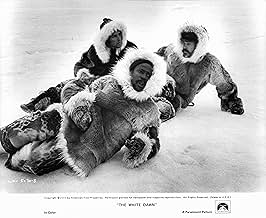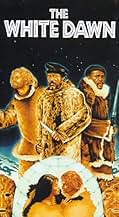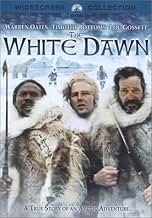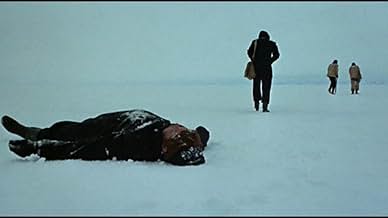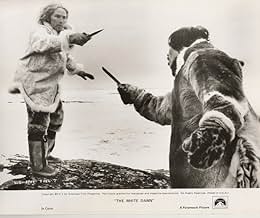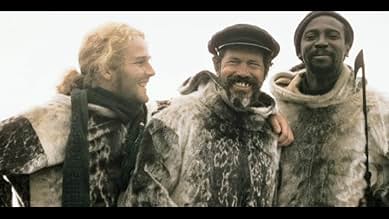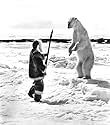IMDb रेटिंग
7.0/10
1 हज़ार
आपकी रेटिंग
अपनी भाषा में प्लॉट जोड़ेंIn 1896, three survivors of a whaling ship-wreck in the Canadian Arctic are saved and adopted by an Eskimo tribe but frictions arise when the three start misbehaving.In 1896, three survivors of a whaling ship-wreck in the Canadian Arctic are saved and adopted by an Eskimo tribe but frictions arise when the three start misbehaving.In 1896, three survivors of a whaling ship-wreck in the Canadian Arctic are saved and adopted by an Eskimo tribe but frictions arise when the three start misbehaving.
Louis Gossett Jr.
- Portagee
- (as Lou Gossett)
Ann Meekitjuk Hanson
- Neevee
- (as Pilitak)
फ़ीचर्ड समीक्षाएं
I saw this film last year at the Chicago International Film Festival with Philip Kaufman and Prof. Annette Insdorf presenting and I was totally blown away. It is both a beautiful love story between a white man and an Inuit woman and a big, spectacular adventure film. There are some amazing scenes, one involving polar bear (this scene alone is amazing and worth seeing the film for) , seal hunting, walrus hunting, boating in the treacherous ice-floes, etc. The performances are excellent from Timothy Bottoms , Warren Oates, Louis Gosset, Jr. and the wonderful actors of the Inuit community. The film continually takes your breath away and has some of the most beautiful love scenes I've ever seen. It's apparently based on a true story of the first encounter of the Inuit with the Dog Children (us). The film has some heartbreaking scenes (which I won't discuss) and the acting by the untrained Inuit actors is truly spectacular. I can't recommend this film enough.
This movie contains what is surely one of the strangest, most unique, and most fascinating scenes in the history of cinematography.
The scene is of an Inuit (Eskimo) ritual. I believe it to be authentic. The screenwriter (who also wrote the original book) lived among and studied the Inuit people for decades and was probably one of the world's foremost (non-Inuit) experts on Inuit culture. Furthermore, the movie was filmed on location and using actual Inuit people as actors.
In the ritual, two girls sit cross-legged on the floor, facing each other. They seal their mouths together and take turns blowing air forcefully across the vocal cords of the other person. It creates one of the eeriest sounds I've ever heard. It's kind of a continuous huffing dronal chant, reminiscent of the background drone of bagpipes but without the shrillness. The strangest aspect of it is that there is an undertone of human voices in the sound. You get the feeling that if you listened hard enough, you could make out actual words. It is like no other sound you've ever heard - hair-raising. Who could have ever imagined that the human body could produce such a sound? Basically what they are doing is playing the other person's body like a musical instrument.
The girls continue doing this, apparently for hours, hardly stopping to take a breath. They've got to be hyperventilating, or experiencing a buildup of carbon dioxide in their lungs and blood, and it is incredible that they can go on and on like this without fainting. They must go into some kind of dizzy trance-like state.
I have never seen or heard of this ritual/technique anywhere but in this movie. I was in Alaska the summer of its Centennial year (1967) and was so fortunate to see a great many demonstrations of Inuit culture as part of the celebrations. But I didn't see anything like this, nor have I come across any description of it in my reading.
This movie would be worth seeing, preserving, and collecting on the basis of this one scene alone! (But actually the rest of it is also worth seeing.)
The scene is of an Inuit (Eskimo) ritual. I believe it to be authentic. The screenwriter (who also wrote the original book) lived among and studied the Inuit people for decades and was probably one of the world's foremost (non-Inuit) experts on Inuit culture. Furthermore, the movie was filmed on location and using actual Inuit people as actors.
In the ritual, two girls sit cross-legged on the floor, facing each other. They seal their mouths together and take turns blowing air forcefully across the vocal cords of the other person. It creates one of the eeriest sounds I've ever heard. It's kind of a continuous huffing dronal chant, reminiscent of the background drone of bagpipes but without the shrillness. The strangest aspect of it is that there is an undertone of human voices in the sound. You get the feeling that if you listened hard enough, you could make out actual words. It is like no other sound you've ever heard - hair-raising. Who could have ever imagined that the human body could produce such a sound? Basically what they are doing is playing the other person's body like a musical instrument.
The girls continue doing this, apparently for hours, hardly stopping to take a breath. They've got to be hyperventilating, or experiencing a buildup of carbon dioxide in their lungs and blood, and it is incredible that they can go on and on like this without fainting. They must go into some kind of dizzy trance-like state.
I have never seen or heard of this ritual/technique anywhere but in this movie. I was in Alaska the summer of its Centennial year (1967) and was so fortunate to see a great many demonstrations of Inuit culture as part of the celebrations. But I didn't see anything like this, nor have I come across any description of it in my reading.
This movie would be worth seeing, preserving, and collecting on the basis of this one scene alone! (But actually the rest of it is also worth seeing.)
This little-known film of Philip Kaufman's is a look at a culture not seen much in films, that of the Innuit, or Eskimo people of Arctic Canada. Three whalers (Warren Oates, Timothy Bottoms and Louis Gosset Jr.) are stranded among them after a shipwreck. The year is 1896 but it could just as well be 1996 or 1796 as far as we can tell in this simple world where survival against nature is always the biggest concern. Surprisingly to me, the culture clash does not seem to be that great through most of the movie, and when it comes, it does so rather quickly. I think this makes for a less strong film but it's still an interesting one that really fascinates at times.
Cinematographer Michael Chapman ('Raging Bull') provides some great shots of the Great White North and Henry Mancini's score is very nice also. Martin Ransohoff is usually known as a producer but co-wrote the script here with Thomas Rickman.
Cinematographer Michael Chapman ('Raging Bull') provides some great shots of the Great White North and Henry Mancini's score is very nice also. Martin Ransohoff is usually known as a producer but co-wrote the script here with Thomas Rickman.
"The White Dawn" unfolds at a pace that I'm pretty sure many young people will be turned off by. There isn't really much of a plot here, for starters, and the movie unfolds at a pretty leisurely pace. Also, there isn't a terrible about of development for the characters played by Oates, Bottoms, and Gossett. But I have to admit that despite all that, I found the movie fairly captivating. The movie is slow, but it has a kind of hypnotic spell that kept me watching. Also, the depiction of the Inuit seems pretty authentic - I'm no expert on Inuit culture, but it sure seemed authentic. (One interesting detail is that it shows that the Inuit didn't have some sort of paradise lifestyle - they had problems like starvation, for example.) If you are looking for a movie that is quite different than usual - both in its subject matter and its telling - this movie is worth a look.
There's a lot to admire about this movie, but very little to enjoy. Crusty old Warren Oates really sinks his teeth into the role of a crusty old whaler, shipwrecked among the Eskimos. The native actors are brilliant. The authentic arctic scenery is beautiful, the native culture is intriguing, the ending is powerful and tragic.
The problem is that everything that happens is so damned predictable. The story is told in such a portentous, pretentious way, like the film makers think they're saying something incredibly profound about the failures of the white man's civilization. But there's nothing said here that wasn't said much better in books like TYPEE by Herman Melville, or even earlier movies like A MAN CALLED HORSE starring Richard Harris.
I mean, sure, the drunken whalers behave like pigs. And sure, you can see why the Eskimos reach their breaking point and start fighting back. But the dated Sixties bias of the film makers is so pitifully obvious. The preaching drags the drama down time and again. You really expect Oates' character to start shouting "Grease 'em all! Torch this place!" like he's Sergeant Barnes in Platoon. And you really expect the young, blonde sailor to start crooning "make love, not war," while he's balling the hot young Eskimo chick.
This isn't a movie about real Eskimos and real whalers -- it's a hippie film maker's fantasy about demonized whites and idealized natives.
The problem is that everything that happens is so damned predictable. The story is told in such a portentous, pretentious way, like the film makers think they're saying something incredibly profound about the failures of the white man's civilization. But there's nothing said here that wasn't said much better in books like TYPEE by Herman Melville, or even earlier movies like A MAN CALLED HORSE starring Richard Harris.
I mean, sure, the drunken whalers behave like pigs. And sure, you can see why the Eskimos reach their breaking point and start fighting back. But the dated Sixties bias of the film makers is so pitifully obvious. The preaching drags the drama down time and again. You really expect Oates' character to start shouting "Grease 'em all! Torch this place!" like he's Sergeant Barnes in Platoon. And you really expect the young, blonde sailor to start crooning "make love, not war," while he's balling the hot young Eskimo chick.
This isn't a movie about real Eskimos and real whalers -- it's a hippie film maker's fantasy about demonized whites and idealized natives.
क्या आपको पता है
- ट्रिवियाAccording to producer Irwin Winkler, this movie was the main factor in his decision to invite director Philip Kaufman to direct The Right Stuff (1983). Portions of Henry Mancini's score for this film can be heard in the later film.
- इसके अलावा अन्य वर्जनThe film was originally given an "R" rating from the MPAA due to the nudity which was then edited for the film to receive a "PG" rating.
- कनेक्शनReferenced in Realizing 'The Right Stuff' (2003)
टॉप पसंद
रेटिंग देने के लिए साइन-इन करें और वैयक्तिकृत सुझावों के लिए वॉचलिस्ट करें
- How long is The White Dawn?Alexa द्वारा संचालित
विवरण
बॉक्स ऑफ़िस
- बजट
- $17,00,000(अनुमानित)
इस पेज में योगदान दें
किसी बदलाव का सुझाव दें या अनुपलब्ध कॉन्टेंट जोड़ें

